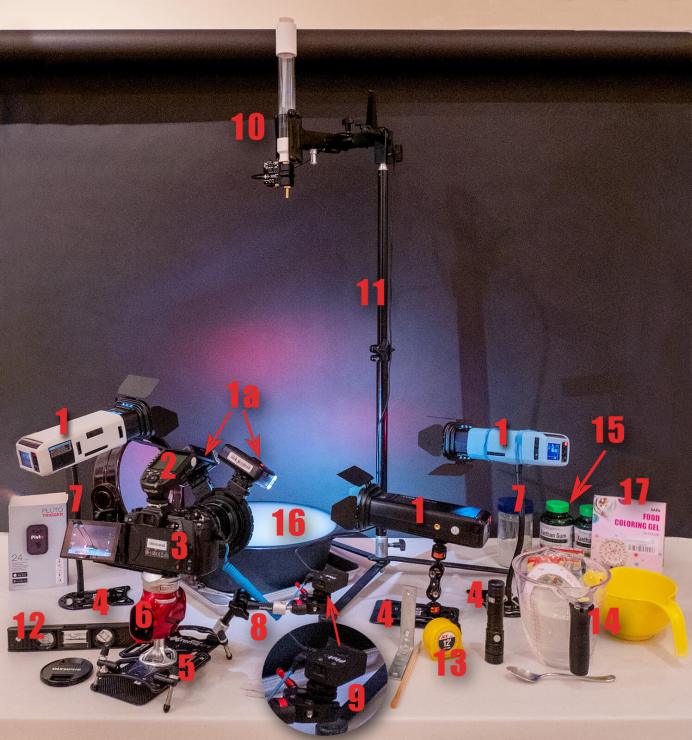Water droplet photography is an amazing challenge, even when you’re working with timing tools. I’m writing this article to not only help you get started, but to remind myself of initial settings for the next time I try to capture the magic of water splash crashes.
Warning
Water droplet photography is addicting! I find each time I shoot I spend two to three days capturing images as even when you have it down the science variables are endless. Changing filters for lighting colors, viscosity of the dropped liquid, temperature, timing and/or size of water drops, etc. ANY change to anything yields different results. Lots of magic is possible! Onward.
Water droplet photography gear
Let’s start with the gear that can make your foray into water droplet photography easier. In the list below you’ll find necessities and niceties. I’ll note which is which. When I mention brand names it is because of the ones I am using.

- Three Godox Speedlight Flashes — If you are just starting out you could try using a single flash unit. Three adds lots of creative lighting options. 1A – Godox MF12 Macro light kit with (2) mounted flashes on the front of the lens. Again this would be optional but adds lighting possibilities.
- Godox trigger — This is paired with my camera and controls the output of the flash units. It can control flash output to all units so you don’t need to adjust individually. Make sure you order the trigger that matches your camera and flashes.
- Olympus OM-D E-M1 Mark III camera with M.Zukio 12-100mm f/4.0 lens.
- Platypod Ultra stands — I have three supporting the flashes. The small footprint of these allows me to work everything in tight.
- Platypod eXtreme — Used as the ball head and camera support. It’s a larger and more versatile support which still has a small footprint. I like this because I don’t need a tripod cluttering the space in front of the set.
- Platyball Elite — You can use your choice of ball head. The Platyball has a very strong mount with no lens creep after it is set.
- Goosenecks — holding the flashes in place but allowing for versatile positioning of the flashes.
- Platypod Magic Arm — Used to support the Pluto Trigger.
- Pluto Trigger — This device makes it possible to perform many additional ways to fire your camera. In this case it is triggering the camera, and each water drop individually from the Pluto dropper.
- Pluto Dropper — Container with circuit board that through the Pluto APP controls that sizes and timing up to three drops to help have somewhat consistent droplet collisions.
- Small light stand — Supports the dropper. You can also work with a light stand just off the back of the table set as well.
- Spirit level — Used to get the dropper level. Helpful to get consistent droplet collisions. Also used to tilt the reservoir a little away from the camera to get a better waterline.
- Tape measure — It’s a good idea to record settings when you have success. Height of dropper over water and flash and camera distance from splashes can be helpful when trying to replicate the set in the future.
- Measuring cups — Helpful for mixing and pouring solution into dropper.
- Xanthan Gum — Increases the thickness of the water drops. This gives a smoother look to the drops and aids in less tiny splashes which need to be retouched.
- Container — Container for catching droplets and splashes. You only need plain water, no need to thicken. If you want a different brighter look you can add a small amount of cream, half and half or other liquid. I had good results with almond milk to turn the reservoir white.
Extras to have on hand
In addition, you will need towels, lens wipes and a tray to capture the overflow liquid. Each time you release a set of drops the water will overflow. I use a chop stick to set focus.
Now that you have all the things you need to get started it’s time to prep your liquids, test your lighting and start dropping water. I’ll share that in the next article.
Yours in Creative Photography, Bob
Tell your story with the second annual Visual Storytelling Conference!
Experience four days of interactive, online training sessions featuring a range of educational content with experienced photographers and content creators. This free event kicks off with a series of technical boot camps to build essential skills, followed by live, online sessions on photography, video, business and social media. Join live from March 10-13, 2022!
